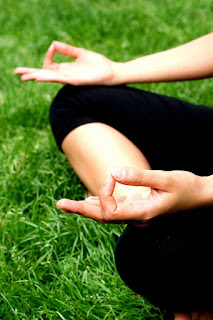Hatha Yoga

Hatha yoga refers to the physical practice of yoga, or "union" of the body, mind and Self and of the individual consciousness with that of the Universal, the source of Creation. Hatha yoga consists of asana (yoga postures), pranayama (breathing exercises), and meditation. In the yogic text the Hatha Yoga Pradipika, it is said that Hatha Yoga and Raja Yoga, the yoga of meditation are inextricably linked. One cannot have one without the other. Hatha Yoga is there to cleanse the body and improve the health , fitness and clarity of mind of the yoga practitioner so that meditation can occur spontaneously as a path to spiritual development. The Hatha Yoga postures are also practiced in a meditative state. So, rather than being two separate steps in a process, Hatha Yoga and Raja Yoga are practiced together from the beginning, with a deepening sense of union as the practice develops.
The Meaning of the Word "Hatha"
Very briefly put, the component, "Ha", means sun in Sanskrit. It represents the "positive" part of the whole, and consists of many qualities, such as the energy of the sun, light, passion, activity, and creativity. The component "Tha" means moon in Sanskrit. It represents the "negative" part of the whole, and consists of many qualities, such as lunar energy, coolness, passivity and receptivity.
Very briefly put, the component, "Ha", means sun in Sanskrit. It represents the "positive" part of the whole, and consists of many qualities, such as the energy of the sun, light, passion, activity, and creativity. The component "Tha" means moon in Sanskrit. It represents the "negative" part of the whole, and consists of many qualities, such as lunar energy, coolness, passivity and receptivity.
The Nadis - Channels of Energy in the Body
Hatha Yoga's practices aim to cleanse the body and mind, and to purify the spirit. The nadis are the essential energy channels or pathways that run through the body, carrying prana, the life force, which is electrically charged. In the Hatha Yoga Pradipika, there are said to be 72,000 nadis in the body. The three main ones are named as follows, in Sanskrit:
Pingala Nadi: associated with the right side of the body, (through crossing through both sides), this nadi corresponds to the left hemisphere of the brain. Working with this channel in yoga we can stimulate our left brain activity. The right side of the body is positively charged electrically.
Ida Nadi: associated with the left side of the body, (through crossing through both sides), this nadi corresponds to the right hemisphere of the brain. Working with this channel in yoga we can stimulate our right brain activity. The left side of the body is negatively charged electrically.
Sushumna Nadi: the central energy channel running in line with the spine, this is where prana, the life energy flows when the nadis are cleansed and the body's energy is balanced through dedicated practice. This is what is referred the raising of the Kundalini Shakti, or energy which leads the yogi to Samadhi, or enlightenment, the eighth limb of yoga. See Patanjali's Eight Limbs of Yoga.
The attainment of Samadhi is a highly spiritual endeavor .It 's pursuit can be seen as a reminder that the practice is not about the goal but about the journey. It is the yoga that we practice with dedication that is the real experience. This enriching experience which can and has taken many dedicated yogis to a point where health, healing, vitality, longevity and the realization of, as well as the fulfillment of one's life purpose are not too high an aim. Or at least some benefits may have been noted from the practice. But the practice of yoga is a continuous journey. The aim is not to do yoga, and then stop. Yoga is a philosophy - a way of life. Certainly, at some points in life we may be more compelled to practice than others, and the nature of our personal practice may change, but once experienced, yoga is a valuable tool for life.
Sushumna Nadi: the central energy channel running in line with the spine, this is where prana, the life energy flows when the nadis are cleansed and the body's energy is balanced through dedicated practice. This is what is referred the raising of the Kundalini Shakti, or energy which leads the yogi to Samadhi, or enlightenment, the eighth limb of yoga. See Patanjali's Eight Limbs of Yoga.
The attainment of Samadhi is a highly spiritual endeavor .It 's pursuit can be seen as a reminder that the practice is not about the goal but about the journey. It is the yoga that we practice with dedication that is the real experience. This enriching experience which can and has taken many dedicated yogis to a point where health, healing, vitality, longevity and the realization of, as well as the fulfillment of one's life purpose are not too high an aim. Or at least some benefits may have been noted from the practice. But the practice of yoga is a continuous journey. The aim is not to do yoga, and then stop. Yoga is a philosophy - a way of life. Certainly, at some points in life we may be more compelled to practice than others, and the nature of our personal practice may change, but once experienced, yoga is a valuable tool for life.


